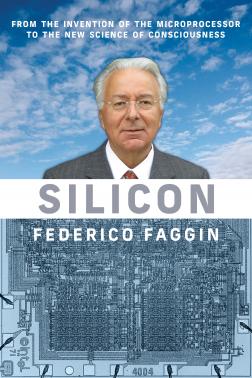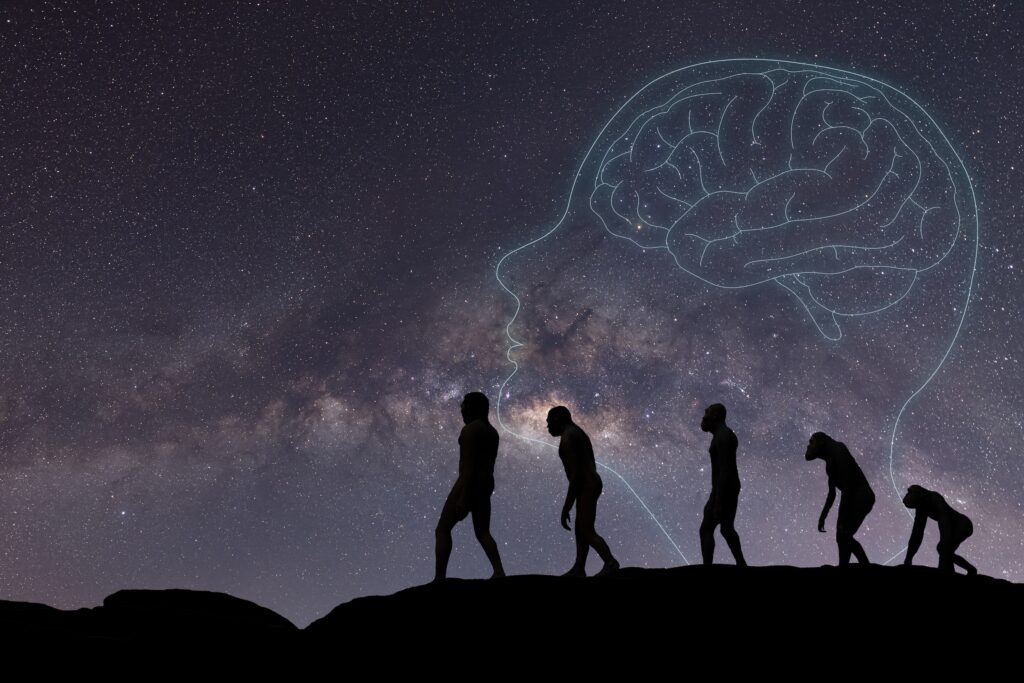The primordial quantum language
Reading | Physics
![]() Federico Faggin | 2021-05-23
Federico Faggin | 2021-05-23

Consciousness is the inner reality of the world, governed by the laws of coherent quantum systems, while matter is but an expression of the meaning inherent in this inner reality. The classical world of matter conforms to the statistical properties of a primordial quantum ‘language’ spontaneously used by the inner quantum reality to express itself. That is the reason why quantum events seem to be probabilistic. Living beings straddle these two worlds—the inner, quantum world of experience and meaning, and the outer, classical world of physical entities—by giving physical expression to their conscious inner being. These are the insights of physicist—and inventor of the microprocessor—Federico Faggin in this captivating essay, edited from his recent book, Silicon.
Imagine a large town square where there are hundreds of people, animals, and objects emitting vibrations (symbols) that are perceivable as sounds (qualia). Each entity contributes a small amount of vibrations that propagate everywhere and are superimposed upon the rest of the vibrations present at each point in the space of the square. Each conscious entity can choose to pay attention only to a small fraction of these vibrations, and the ones selected constitute an observation that is experienced as sound and is understood to some extent. Each entity responds then to its inner experience by contributing new vibrations that are added to those of the square.
If we now consider only the conscious entities, the outer symbolic vibrational reality of the square is the sum of the vibrations produced by all those entities. The inner semantic reality of each entity 1s thus affected by the entity’s free-will decisions about which subset of vibrations to observe and experience. In response to its observation and experience, the entity will then make a free-will decision about which vibration to contribute, thus affecting the outer reality once more. In general, each entity constantly repeats cycles of observation or perception, comprehension or experience, and response or action.
In this example, we see clearly that the outer reality affects the inner reality and that the inner reality affects the outer reality. We also see that the entity’s vibrations emitted in response to the inner experience represent a top-down influence on physical reality because they affect the motion of the air molecules. Notice however that the top-down and inside-out influences upon reality are contrary to the worldview of classical physics but not the worldview of quantum physics. In other words, my conscious choice of what meaning to communicate is not made by the atoms of my body, even though my conscious experience leading to that choice is affected to some extent by the physical configuration of my atoms. Once I make a choice, my conscious command will affect a subset of the atoms of my body, and these in turn will affect my physical behavior in such a way that the pattern I emit will represent the intended meaning. Said differently, that pattern has both a symbolic content (air vibrations) belonging to the outer reality, and a semantic content, the qualia and meaning that belong to my inner reality. There must be two-way communication between the semantic level of inner experience and the outer informational level, with the semantic level affecting the symbolic level and vice versa.
Let us now return to the square full of conscious entities producing vibrations. At any one time each entity observes only a small subset of the overall vibrations, neglecting the rest of them which are considered background noise. For example, my experience will be quite different from my neighbor’s, who is listening to someone I am not engaged with. Similarly, in the experience of the nearby dog, who is only paying attention to the barking of other dogs, all other sounds may be considered background noise.
Notice that in the vibrational reality of the square, there are neither objective symbols nor objective noises, even though the physical vibrations could be objectively described by an equation. Since what is signal and what is noise are determined primarily by the free-will choices of each observer, having a definite equation is not enough because the equation contains parameters that are unknowable until the free-will choices have been made. Furthermore, since each observer has only a single point of view, no entity can simultaneously experience the vibrational reality of the square from two or more different points of view. The point I am making here is that we often think we have solved a problem by devising a general mathematical equation but if the parameters of that equation are impossible to obtain, the problem has not been solved.
Within classical physics, everything is external reality because the outer properties of the elementary particles are the only determinants of the properties of any hierarchical structure made of particles. Based on this premise, no inner reality can exist in any organization of classical particles.
Within quantum physics, however, there is the possibility that each hierarchical level of quantum states might have some degree of freedom not entirely accounted for by the behaviors of the hierarchical level immediately below it. For example, the properties of a water molecule are more than the sum of the properties of the hydrogen and oxygen atoms. A water molecule has novel properties that involve some integration of lower-level properties into something new (not a sum), with new constraints between the parts, and new freedoms accessible to the molecule but not available to its parts.
If we imagine that consciousness and free-will are inner properties of the quantum fields, then the outer state of each field could be changed by the field itself. Therefore, the outer state of the field would reflect its inner semantic reality. Those outer states would then correspond to the vibrations imposed by a conscious entity onto the air molecules in the example of the square previously described. Those vibrations would reflect the meaning that the conscious entity intends to communicate to the other fields since the outer information is correlated with the meaning.
Vibrations must be “quanta,” each quantum corresponding to a discrete symbol of the language used to communicate, and each symbol is the result of a free-will choice made by the conscious entity. Therefore, the symbol that appears cannot be known a priori and can only be mathematically described by a probability. This probability, however, does not indicate a lack of knowledge, like classical, objective probability does, but refers to an act of creation. The creator knows which symbol it will emit, but no outside observer can possibly know that symbol before its creation. The probability that describes the appearance of symbols in human verbal communications is called subjective probability. It is the same probability used by quantum physics, even though this interpretation is not generally accepted by physicists.
An interesting reflection is that, when two people verbally communicate, the words they use do obey the probabilistic, syntactical laws of symbols of the language they use. These laws are obeyed out of cooperation, not out of coercion, because people desire to communicate and understand each other. My crucial insight here is that, while the meaning people are communicating is not predetermined, the syntactical laws of symbols in which any meaning will be expressed are probabilistic mathematical laws that will be obeyed no matter what meaning is expressed.
For example, the book I will write five years from now is guaranteed to precisely obey the syntactical laws of English—the language in which it will be written. This is true even though I have not yet decided what I am going to write about, i.e. the meaning is largely independent of the elementary symbols I am going to use to express it. For example, the probability of finding a letter “e” in my future book will be 0.12702, exactly the same probability of finding the letter “e” in this essay (the probability can be found by counting the total number of letters “e” divided by the total number of letters in the book).
Most physicists believe that the universe is constructed out of the interaction of quantum fields whose states represent meaningless, abstract symbols obeying the probabilistic laws they have discovered. However, if what matters to conscious entities is the meaning expressed by those abstract symbols, I fear that physicists will never know that the universe is alive and conscious because they attribute reality only to information without meaning.
If we interpret the appearance of an elementary particle at a specific point in space and time as a communication symbol, like a letter in the alphabet of the universal language “spoken” by the conscious quantum fields, and if we take quantum entanglement as evidence that particles are part of larger organizations of symbols, then, the quantum state of a coherent quantum system that qualifies as a conscious entity may be interpreted as having a dual nature: it is a quantum symbol to the outer objective world, and a subjective meaning to the conscious entity that created that state. The only additional assumption necessary for this interpretation is to hypothesize that the quantum state of a conscious entity has a meaning to the entity itself.
The universe described by Quantum Field Theory (QFT) and General Relativity (GR) is inherently dynamic and holistic, yet it represents only the outer aspect of reality and cannot account for the existence of our inner reality unless interiority is also present from the beginning. If we take seriously the evidence of our inner reality and the impossibility of explaining its existence with abstract information without meaning, all ontological entities may have an inner reality as well. This means that the quantum fields, which are the fundamental ontological entities of the known universe, must also have an inner conscious reality just as we do. To explain how a universe containing conscious beings may emerge from the quantum vacuum, we must then postulate that the quantum vacuum is inherently conscious as well.
Imagine the world of events that we can measure, emerging from a more fundamental quantum world in which much more is happening than can be measured. The first world is the classical world characterized by Boolean or classical information and the second world is the quantum world characterized by quantum information. These two worlds interact, meaning that quantum information can be transformed into classical information and vice versa. Because of this interaction the two worlds are not separate, yet both worlds are real, and within each world there are entities that can exist only in one or in the other. There are also entities that simultaneously exist in both worlds, straddling the two, so to speak. These are the living organisms.
The entities that exist only in the classical world interact with deterministic laws using classical information and thus behave mechanically like our machines and our computers. The entities existing only in the quantum world interact with quantum laws based on quantum information. Living organisms are special because they exist in both worlds. This interpretation of quantum physics assigns reality to the quantum world. It is unlike most other interpretations in which only the classical world of measurable events is considered real.
In the framework I am proposing, conscious entities exist in the quantum world, and these entities use quantum information to communicate with each other. To represent quantum information, I am assuming the existence of a “substance” of which everything that exists is “made,” whether quantum or classical. This substance is like the energy of physics, but it has the additional property that it can experience itself. To avoid any confusion, I decided to call this universal substance, nousym, the portmanteau of nous (higher mind in Greek) and symbol. Nousym is a holistic and dynamic substance with extraordinary properties: it is the “stuff” that manifests in our classical world as the matter-energy of physics.
One of the revolutionary discoveries of modern physics has been that energy only comes in discrete quanta. By induction, nousym also shares this property and its quanta can be entangled to create vast coherent structures that can exist and evolve in the quantum world. The crucial idea is to postulate that these coherent structures are conscious entities with a unique identity and free-will. Each coherent entity has an outer aspect “made” of quantum information and an inner aspect “made” of qualia and free-will. The qualia express the existence of a conscious experience and the free-will expresses the capacity of the entity to affect its outer information.
If we now go back to the large town square example with people and animals producing sounds, the vibrating air carrying the sounds made by the communicating entities would be analogous to the “vibrating” nousym carrying the superposition of the information of the communicating quantum entities. Like in the case of the square, the state manifested by a conscious quantum entity A, say, would be a free-will choice made by A and therefore known by A before its manifestation. Viewed by any other entity, however, the appearance of that state would have to obey probabilistic physical laws, since it was freely chosen by A. Something similar also happens when a scientist prepares an elementary particle in a particular state. The scientist can predict with confidence the state that will be measured, whereas any other observer who does not know about the preparation can only know the probability of measuring that state.
We can now turn our attention to the systems that straddle the classical and the quantum worlds. Many years ago, I saw a short documentary of a paramecium happily swimming inside a drop of water. A paramecium is a protozoan, a single-cell animalcule, whose body is like a miniature short cigar, about 0.1 mm long, covered by thousands of villi: microscopic whiskers that beat in unison and can propel it in water. Well, this little “thing” could swim quite fast, avoid obstacles, seek and find food, find a mate, and generally behave intelligently with clear purpose, like a little fish.
“But the paramecium is a single cell!” I exclaimed. “It has no nervous system!”, “How can just a bag of chemicals process information in such an exquisite manner? How can it reproduce by assembling a copy of itself within itself?” This is not a program that can copy itself within the computer memory. This is akin to a computer assembling another computer like itself within itself—hardware and software included—and then dividing into two complete computers! These are feats no engineer could match today. I concluded that there must be something fundamental going on that we do not yet understand.
Any living organism, from bacteria to man, is an open system, i.e. a system that exchanges matter, energy, and information with the environment in which it lives. To survive, an organism requires food, i.e., a continuing supply of matter and energy, and the ability to self-regulate. The capacity for self-regulation, called homeostasis, allows the organism to maintain internal stability by means of many interoperating dynamic processes that use negative feedback.
Stability is achieved via a dynamical equilibrium around some set points, just like what happens with a thermostat that automatically adjusts the temperature in a home. Of course, within a cell there are homeostatic cycles inside other homeostatic cycles in bewildering complexity, though the basic operating principle of each cycle is always the same, i.e. to feedback the value of the variable to be controlled, compare it to a set value, and drive the process until the difference between the two is negligible.
If we look closely at a eukaryotic cell, its operation is completely different than the way our machines work, including computers. Inside the cytoplasm of the cell there are electrons and protons (hydrogen ions);i ons of simple atoms such as sodium, potassium, phosphorous, and so on; simple molecules like water, glucose, and amino acids; complex molecules like messenger RNA; proteins; organelles like ribosomes and DNA; and mitochondria that are like simple bacteria—living cells inside a larger cell.
The cell therefore contains many hierarchical organizational levels, all working seamlessly together in unbelievable complexity and with a single purpose. Each part of a cell can interact with very many other parts in both a feedforward and a feedback manner without permanent connections among them. This freedom is unlike any found in a computer, for in a computer the connections of its transistors are fixed once and for all by its designer, and its matter does not move in and out of its physical boundaries.
A cell is like an irreducible whole, a fundamental “atom” out of which complex living organisms can be constructed by using trillions of them organized in a remarkable way. In fact, when we manipulate life, we always start with a living cell, not with its component parts, and it’s only because of the robustness and fault-tolerance of cells that we can make certain invasive manipulations without killing them in the process.
Everything going on in a living organism intimates that such a physical structure cannot be completely understood within the logical framework of the classical world, even though much of what is happening can. There are many properties that require quantum physics to be understood, and even many of the properties we consider classical are approximations of quantum properties good enough to classically explain what happens. What we cannot account for classically is the fact that living organisms are conscious and autonomous with probabilistic behavior.
I think it will be impossible to explain life without the concept of consciousness because the two are inextricably linked in ways we have yet to comprehend. A living organism has purpose only because it can “host” a conscious entity and can thus act as a unit endowed with free-will, intention, and meaning; properties that cannot arise from a bag of unconscious classical atoms and molecules interacting with each other. I think that consciousness must play not only the role of the “glue” that holds together the unity of the organism, while it constantly changes, but also be the “agent” behind its free-will actions.
Life exists in a deep and abiding symbiosis with the environment with which there is a constant exchange of matter, energy, and information in a profoundly dynamic equilibrium where the organism is never the same throughout its lifetime. And so is the environment never the same from the viewpoint of the organism. In fact, the two coevolve, and what is inside the organism at one time may be outside the next, and vice versa, like two complementary aspects of a single dynamic and holistic structure. I will now resort again to a metaphor to more clearly explain how I envision life straddling the quantum and the classical worlds.
In the framework I am developing, conscious entities exist entirely in the quantum world and each one has the qualia perception, comprehension, and free-will to direct the physical body which is a quantum-classical structure. The quantum portion of the body interacts with the quantum conscious entity and the classical portion of the body interacts with the classical world of which it is part. The conscious entity is the “self” we really are, though we erroneously believe we are the body.
In this framework the conscious entity may control the body both directly and indirectly. Direct or explicit control is when we consciously make a choice, therefore we explicitly know the choice we make. An indirect or implicit control is when a barely conscious desire (a quale) we never consciously examined—but we could have—may direct the classical machinery of the body without us being aware of. The important point is that the “desire” is a quantum property that controls the classical information of the body.
When the conscious entity is identified with the body, meaning that it believes itself to be the body based on the data coming from the body’s classical senses, the entity loses contact with its vaster quantum reality thinking that all that exists is the physical world with the characteristics that are registered by the senses. At this point I will resort to a virtual reality metaphor to further illustrate this situation.
Imagine controlling an avatar in a virtual reality world created by a computer. You wear sophisticated goggles, earphones, and a costume that automatically captures the movements of your body. Your voice and your motions control the actions of the avatar, and through the simulated senses of the avatar you experience a virtual world as if you were the avatar you control. In that virtual world there are virtual classical objects and other avatars, each controlled by a different person. You interact with them using the laws of the virtual world and may experience a different world than the physical one you know.
The computer program that runs the virtual world includes the avatars as subroutines and is totally classical. If you get engrossed in that virtual reality, you may almost believe for brief periods that you are the avatar and that the virtual world is real, forgetting that you exist in the physical world instead. The capacity of our consciousness to focus onto a portion of our experience about which we feel a strong interest is something we are all familiar with. In the game of life, most of us are completely identified with our body because we can only affect the world classically and therefore end up paying attention only to the classical information coming from the body. This conditioning occurs early in life, facilitated by the seamless interface between our consciousness and our body, contrary to the crude interface between our body and the avatar.
When you control the avatar, your body clearly exists outside the classical computer and the avatar is not who you are even when you are engrossed in the game. Your classical body controls top-down the avatar with classical information, but your quantum body is in turn controlled by the quantum conscious entity—the real you—that exists in the quantum world. Notice that your experience of the virtual world is also a quantum phenomenon occurring within the same “you” that controls the body that controls the avatar. Therefore, the avatar may perform actions that could not have originated digitally since they depend on your free-will decisions occurring in the quantum world.
I think that just like your body does not exist inside the computer that creates the virtual reality, your consciousness and free-will do not exist inside the physical world in which your body exists. The avatar is just an interface allowing you to interact and have an experience in the classical virtual reality created by the computer, but your experience exists neither inside the avatar nor inside the computer. Likewise, your body is just an interface to the physical world that contains your body and the computer, but your experience of body and world is neither inside the body nor inside the physical world. It is only because you believe the physical world is the only reality in existence that you attribute your experience to the body.
The real entity is not your body but your conscious self who is “wearing the body,” just like your body is “wearing the avatar.” You exist solely in the quantum world and inside the quantum world there is a quantum-classical physical world in which your body exists; and inside the physical world there is classical computer in which there is a virtual world that contains an avatar that your body can control. Like Russian dolls, there are virtual realities inside virtual realities, but it is nousym that contains your conscious experiences of all those dolls and the quantum information out of which all those dolls are physically made.

Essentia Foundation communicates, in an accessible but rigorous manner, the latest results in science and philosophy that point to the mental nature of reality. We are committed to strict, academic-level curation of the material we publish.
Recently published
Reading
Essays
Seeing
Videos
Let us build the future of our culture together
Essentia Foundation is a registered non-profit committed to making its content as accessible as possible. Therefore, we depend on contributions from people like you to continue to do our work. There are many ways to contribute.
















